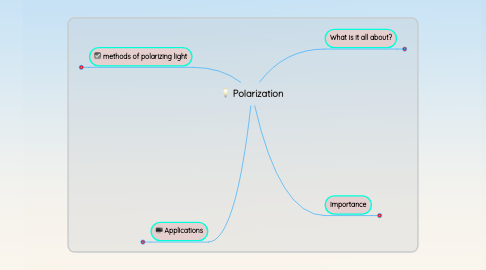
1. methods of polarizing light
1.1. Polarization by Transimission
1.1.1. most common method of polarization involves the use of a Polaroid filter
1.1.2. A polarizer has a transmission axis, and it passes the components (projections) of the electric field vectors that are parallel to its transmission axis.
1.2. Polarization by Reflection
1.2.1. When unpolarized light is incident at this angle, the light that is reflected from the surface is therefore perfectly polarized
1.3. Polarization by Refraction
1.3.1. If light is incident upon a glass surface, then a part of that light will be refracted and the other part reflected. At the same time, it is polarized in such a way that the vector of the electrical field strength of the polarized reflect.
1.4. Polarization by Scattering
1.4.1. Polarization also occurs when light is scattered while traveling through a medium. When light strikes the atoms of a material, it will often set the electrons of those atoms into vibration.
2. Applications
2.1. used in numerous applications -liquid crystal display (LCD)
2.1.1. clocks
2.1.2. wrist watches
2.1.3. computer screens
2.1.4. timers
2.2. entertainment industry
2.2.1. to produce and show 3-D movies.
2.3. In industry
2.3.1. Polaroid filters are used to perform stress analysis tests on transparent plastics
3. What is it all about?
3.1. the action of restricting the vibrations of a transverse wave, partially to one direction.
3.2. carries
3.2.1. information
3.3. the following can all affect the polarization of a beam of light.
3.3.1. magnetic fields
3.3.2. crystal structures
3.3.3. mechemical stresses
3.3.4. quality vibrations
3.3.5. chemical interactions
3.4. The electric field is vibrating in many directions; all perpendicular to the direction of propagation. it can be...
3.4.1. horizontal
3.4.2. vertical
3.4.3. diagonal
4. Importance
4.1. Polarization is also very important in the chemical, pharmaceutical, and food and beverage industries.
4.1.1. pharmaceutical,
4.1.2. chemical
4.1.3. food and beverage industries
